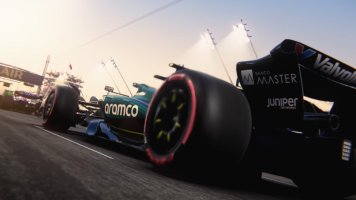I have a Oculus Rift S and I’m interested in a Reverb G2. My Rift is serving me well but it going into obsolescence. Issue is the Reverb while nice needs more resources than my current system which is a Rysen 7 , with a Nvidia rtx 2060 which which will only run the Reverb a 1/2 res, which still might be better. I don’t plan to upgrade the GPU anytime soon. Opinion, stick with the Rift or go Reverb. Probably no right answers but I‘d be interested in hearing. Thanks
You are using an out of date browser. It may not display this or other websites correctly.
You should upgrade or use an alternative browser.
You should upgrade or use an alternative browser.
VR choice
- Thread starter Gadget_x910
- Start date
metalnwood
Premium
I remember when the G2 was coming out that test indicated at 1/2 resolution it was still a bit clearer than the rift S. As well, you won't have the same screen door effect that you have with the rift S.
So graphics wise it will be at least a slight upgrade although not reaching near the potential of the G2 if it turns out you have to run it at 1.2 res.
Other than thta I can say that at least for me, the G2 was more comfortable in every way. Its not as hot, the halo of the rift S I never found to be great and much prefer the more conventional style of the G2. The other thing, the rift S was never a good match for my IPD. A problem that was solved with the G2 and the adjustable IPD.
There could be those other benefits for you as well, but I can't advise if it's worth it to you.
So graphics wise it will be at least a slight upgrade although not reaching near the potential of the G2 if it turns out you have to run it at 1.2 res.
Other than thta I can say that at least for me, the G2 was more comfortable in every way. Its not as hot, the halo of the rift S I never found to be great and much prefer the more conventional style of the G2. The other thing, the rift S was never a good match for my IPD. A problem that was solved with the G2 and the adjustable IPD.
There could be those other benefits for you as well, but I can't advise if it's worth it to you.
I'm more or less in the same situation: i7 10700KF + 1080Ti + Oculus Rift S + Assetto Corsa. I don't think I will upgrade my headset until I get a new graphic card. I simply don't want to be again with headaches trying to adjust the graphics not to loose framerate. Have you considered the Valve Index? Its resolution is not as extreme as the G2 and it features more FOV. It's a shame it's so expensive and difficult to find.
I have the G1 and originally had the RTX2060. I could run AC and iRacing on low settings at near native rez of the headset. I moved the SS slider until it was close to 2,100 x 2,100 pixels rendered per eye (I'd recommend you work with the actual pixel counts as the % scale is inconsistent between headsets) - The G1 is designed to run with about another 20% SS (i.e. ~2,400 x 2,400) to keep the middle of the image sharp after the lens distortion, but I didn't quite have the headroom for that so it made the central area of the image a bit 'shimmery', but I found it ok during a race.
I am pretty much in the same situation as you, in that I use a Rift S and own a G2 as well but can't really run it properly. I have a Ryzen 7 5800X and a 1660ti, which is merely good enough to run the Rift on lowered settings but is GPU limited with the G2. I am waiting very patiently for the collapse of the Crypto -GPU wars so I can get my hands on a decent GPU upgrade sometime this year. The G2 is a big step up from the Rift S in comfort and clarity, but it is only viable with a really good GPU.
Last edited:
D
Deleted member 197115
-
Deleted member 197115
With WMR you can also use 60hz mode to compensate for higher res.
RCHeliguy
Premium
I recently joined the Varjo Aero Discord server just out of curiousity. What came out of it recently was interesting.
Apparently the HP G2 has a very bad distortion profile that costs an extra 50% resolution processing which is why the Aero manages to do very well compared to the G2 while displaying more resolution. This is an artifact of WMR. Apparently by writing their own software to handle talking to SteamVR rather than layering on WMR, the Aero offers a much sharper view without pushing the GPU harder.
I believe that was similar to what StarVR was doing when people were floored that it ran well despite having a fantastic FOV.
Apparently the HP G2 has a very bad distortion profile that costs an extra 50% resolution processing which is why the Aero manages to do very well compared to the G2 while displaying more resolution. This is an artifact of WMR. Apparently by writing their own software to handle talking to SteamVR rather than layering on WMR, the Aero offers a much sharper view without pushing the GPU harder.
I believe that was similar to what StarVR was doing when people were floored that it ran well despite having a fantastic FOV.
Last edited:
The specs of that StarVR One are amazing, specially the FOV, which, in my opinion, is far more important than the image clarity. Do you know if it's already on sale?I recently joined the Varjo Aero Discord server just out of curiousity. What came out of it recently was interesting.
Apparently the HP G2 has a very bad distortion profile that costs an extra 50% resolution processing which is why the Aero manages to do very well compared to the G2 while displaying more resolution. This is an artifact of WMR. Apparently by writing their own software to handle talking to SteamVR rather than layering on WMR, the Aero offers a much sharper view without pushing the GPU harder.
I believe that was similar to what StarVR was doing when people were floored that it ran well despite having a fantastic FOV.
OpenXR may help:
I'm on win11 with a 3070ti and I'm getting amazing performance in AC with the reverb g2 when using openxr/opencomposite instead of steamvr. Steamvr is a major bottleneck.

Releases · Jabbah / OpenCompositeACC · GitLab
Reimplementation of OpenVR, passing all calls directly to LibOVR.gitlab.com
RCHeliguy
Premium
I don't think SteamVR is a bottleneck in itself. The default WMR distortion processing appears to be the culprit accounting for an additional 50% resolution processing. Is it possible that you are bypassing that when you do this? I'm not claiming to be an expert on this. I'm just piecing together things I'm seeing in different places.OpenXR may help:
RCHeliguy
Premium
I haven't seen anything retail yet.The specs of that StarVR One are amazing, specially the FOV, which, in my opinion, is far more important than the image clarity. Do you know if it's already on sale?
There is a Developer link on their website, but the page looks stale.
They had fantastic optics on it, amazing FOV, but it's possible they were a bit ahead of the curve.
Last edited:
D
Deleted member 197115
-
Deleted member 197115
200% native resolution as 100% in SteamVR is not WMR specific, it's just barrel distortion correction to compensate for lenses, when you need to retain 1:1 pixel density in blown up center. Valve index is using the same coefficient. If Varjo came up with some special lenses that minimize that distortion thus lowering need to supersampling, that's great, combined with foveated rendering it can provide much needed performance to drive higher res headsets.This is an artifact of WMR.
I believe Pimax was notorious for throwing a bunch of pixels away when sending data to the output, like 1/4. link
Last edited by a moderator:
I have also concluded that is problematic for G2,WMR distortion processing appears to be the culprit
but think I read reports that OpenXR helped G2 performance.
Last edited:
Well no matter what it actually is, e.g. in DCS, where i am able to use OpenComposite and the OpenXR toolkit (Upsampling and/or fixed foveated rendering), using OpenXR instead of SteamVR is good for >15% performance gain with what looks to my eyes like a slightly crisper image.I don't think SteamVR is a bottleneck in itself. The default WMR distortion processing appears to be the culprit accounting for an additional 50% resolution processing. Is it possible that you are bypassing that when you do this? I'm not claiming to be an expert on this. I'm just piecing together things I'm seeing in different places.
Just for reference, that is a similar performance gain than what can be had by upsampling or fixed foveated rendering just by increasing efficiency.
Enabling the holy trinity on DCS improves my fps from just over 30 fps to over 50 fps at a very small decrease in image quality (well considering it would be borderline unplayable at those graphics settings i use, it is actually a a no-brainer). I think that is quite impressive considering this is the performance increase you might expect from something like a 4080 vs. my 3080.
In ACC i see the same equal fps increase OpenComposite vs. fixed foveated via the vrperfkit, unfortunately the OpenXR toolkit does not work with ACC and vrperfkit is for SteamVR, so it is either OpenComposite or vrperfkit.
Last edited:
Latest News
-
Max Verstappen's Busy Double-Victory WeekendMax Verstappen won the 2024 Formula One Emilia Romagna Grand Prix at Imola, but the Dutchman is...
- Yannik Haustein
- Updated:
- 3 min read
-
BMW M8 GTE Completes Trio Of New RaceRoom CarsAfter announcing the M2 CS Racing and the M4 GT4, RaceRoom unveiled the BMW M8 GTE to be the...
- Yannik Haustein
- Updated:
- 2 min read
-
Monster Jam Showdown: 'Just In Monster Jam' Trailer Shows New FeaturesThe team at Milestone have released the newest trailer for Monster Jam Showdown. From off-road...
- Connor Minniss
- Updated:
- 2 min read
-
OverTake Goes Brickyard: Join Our OT IndyCar 500 (km) In rF2 For FreeIt is race week for the Biggest Spectacle in Racing, so our Racing Club is hosting its own...
- Yannik Haustein
- Updated:
- 2 min read
-
Column: A Sim Racer's Fleeting Visits to Laguna Seca and MonacoIn the past few weeks, I have been lucky enough to travel to two iconic venues in motorsport...
- Angus Martin
- Updated:
- 5 min read
-
When German Formula 3 Went Oval RacingOval racing has never really taken off in Europe, despite CART's attempts in the early 2000s...
- Yannik Haustein
- Updated:
- 4 min read
-
Short Oval Racer's First Time Experience With IndyCarFull contact and rough and ready. That's banger racing. However, IndyCar swiftly taught me that...
- Connor Minniss
- Updated:
- 5 min read










